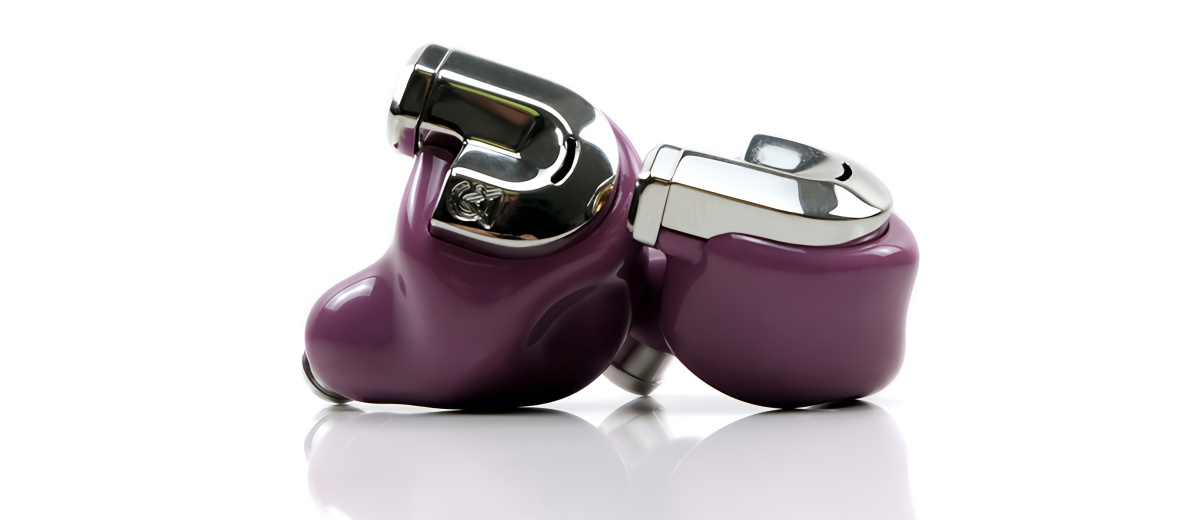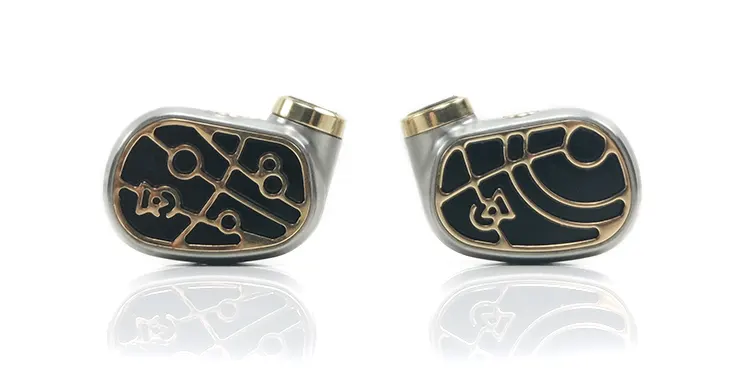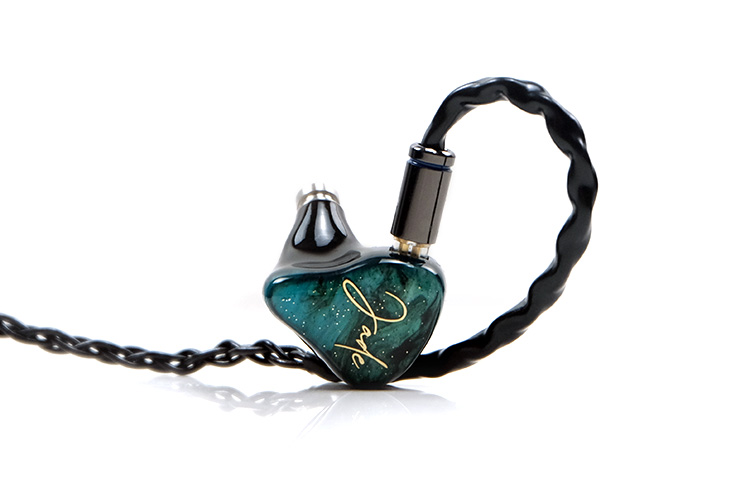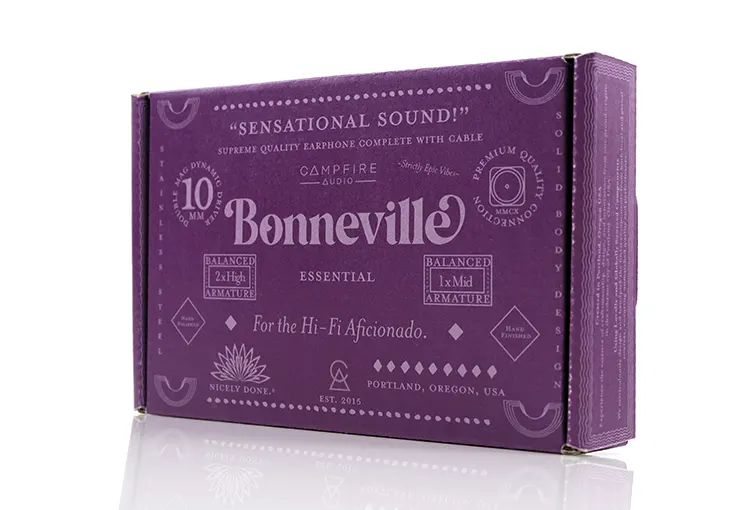Select Comparisons
The following comparisons to the Campfire Audio Bonneville were completed using a mix of the HiBy R8 II and FiiO’s M17 for the main sources combined with the stock silicone tips and Time Series cable.
Campfire Audio Solaris Stellar Horizon
The Solaris Stellar Horizon was launched in early 2023 with our review shortly after. This is a 3rd generation Solaris series model though technically the 4th if you include the 2019 SE model alongside Solaris 2020.
Technical
Both of these models are hybrid 5-driver designs with a single dynamic driver for the lows, and 3 BA for the mids and highs using a single crossover.
The key differences lie in driver choices, particularly on the low end with the Stellar Horizon using the more traditional A.L.D.C. 10mm dynamic driver and the Bonneville using the new dual-magnetic 10mm variant and acting as a woofer.
The new custom midrange dual-diaphragm Knowles driver with dual tweeters for the highs is used by both monitors. However, there is no mention of T.A.E.C. tubeless technology for the Bonneville Tweeter implementation which is a feature inside the Stellar Horizon.
The Solaris Stellar Horizon is the easiest of the two IEMs to drive at 4.4Ω with a 9.145 mVrms rating to obtain a benchmark of 94 dB SPL @ 1kHz. The Bonneville is less sensitive on paper at 14.59 mVrms to reach 94 dB @ 1 kHz for SPL and has a higher load impedance rating of 29Ω @ 1 kHz.
I have to assume that the Bonneville switch to the new dual-magnetic dynamic driver created that gap in efficiency over the older model though technically both are quite easy to drive from most sources.
Design
I think the switch to the acrylic 3D-printed solid body mold for the Bonneville gives it an advantage over the Stellar Horizon.
Granted, the Horizon has some classy looks, and the two-piece precision machined brushed stainless steel housing is far more durable compared to acrylic. However, you can mold an acrylic body more aggressively with the resulting form factor a more accurate fit.
I give an edge to the aesthetics of the Stellar Horizon but appreciate this is entirely subjective. The craftsmanship is more intricate and the materials required are likely to be more costly to acquire. The rune-like design work on the faceplates in particular is gorgeous.
The purple on the Bonneville is groovy and has a more modern metro vibe but the visual has been used before in the customs designs so it’s not quite as unique.
Now in terms of isolation, it will depend on the tips you use since they both come with the same tips. Doing a like-for-like on the silicone tips gave the Bonneville a distinct advantage with foams about even.
The reason for that is the form factor with the shorter nozzle extension and more uniform shape of the Stellar Horizon putting more emphasis on the tip doing the isolation work.
For example, a Final E on the Stellar Horizon isolates much better compared to the stock silicone on the Bonneville and both are even in isolation if both use Final E tips.
Both IEMs come with Time Series cables but the aluminum barrel finishing on the Stellar Horizon is of a higher grade and it comes stock with the 3 terminated cables. Only the Deluxe version of the Bonneville comes with the same triple cable count.
Performance
These two sound signatures are not competing for the same listening preferences, at all. The Bonneville, aside from a noticeable 1-2 bump, is more U-shaped, more colored to the smoother side with a lot more bass power and lower register warmth through and into the lower mids.
The Stellar Horizon is cleaner, and more neutral or accurate sounding. You get a flatter and tighter bass tuning, more open or prominent upper-mids, especially with the HiBy R8 II as your source, and a little more energy also through the lower-mids.
Both monitors have a similar upper treble extension but the Bonneville checks its presence a bit with its more relaxed upper midrange so you only get a light sheen on top of an otherwise warmer tonal quality whereas the treble influence is more integral to the Stellar Horizon timbre.
If you are after a bit more vocal and treble/percussion focus then the Stellar Horizon is the better choice here. It brings a lot more clarity and zest to the table for instruments and most voicing registers whereas the equivalent Bonneville performance is more laid back and a little more distant in the staging mix relative to the bass power.
If you want a better fundamental, lower register body, and a slightly softer less fatiguing quality to your listening experience then the Bonneville will give you that.
I do find that the Bonneville has an edge in staging depth and is almost on par for height but the Stellar Horizon gives you better width and as mentioned a more forward vocal image relative to its bass positioning.
As such you will perceive the Stellar Horizon to be more resolving though the mids and highs courtesy of the additional note definition and contrast the stronger treble presence creates.
64 Audio U4s
The 64 Audio U4s was launched in the spring of 2023 with our review by us giving it a solid score. It is priced slightly cheaper at $1099 though with a similar hybrid driver setup.
Technical
The 64 Audio U4s is a hybrid quad-driver universal in-ear monitor with a 9mm dynamic driver for the lows, a single BA for the low-mids, another again for the mid-highs, and 64 Audio’s patented tubeless tia driver for the highs.
Typically, we would be comparing like for like on the tubeless highs but the Bonneville seems to be one of those rare CA IEMs that does not use their T.A.E.C. tubeless technology. Instead, we have a dual tweeter for the highs, a dual-diaphragm BA for the mids, and a large 10mm dual-magnetic dynamic driver for the lows.
The 64 Audio U4s does have a few more tricks up its sleeve including its apex filtering system and you get a range of pressure-adjusting filters with it as well as their flat impedance LID technology. For this comparison, we will be using the m15 apex filter which is rated at -15 dB of noise attenuation.
The U4S is rated at 11Ω @1kHz and an SPL of 107 dB/mW @ 1kHz so it’s not a like-for-like measurement since CA uses Vrms required to hit a benchmark of 94 dB.
What I can tell you is that subjectively, using the R8 II single-ended, the Bonneville is the more sensitive of the two IEMs despite the higher 29Ω impedance rating.
Design
The U4S is another IEM with a more regimented design approach not a million miles away from the Stellar Horizon form factor.
Its classic 64 Audio design language with a compact matte aluminum shell, smooth cornering, and the signature raised connector stem to the rear. The differences from the other 64 Audio designs are the blue slate color scheme and the new glossy ‘black and grey’ patterned face plate nestling beside the apex filter slot.
The Bonneville is very different with that bolder purple and chrome color scheme, more aggressive contouring from its use of acrylic over aluminum, and a much wider nozzle opening compared to the quite narrow U4S design. The Bonneville also uses MMCX connectors as opposed to 2-pin.
With the more rigid form factor, the U4s does place more emphasis on the tips working the seal. Combined with the apex filter system there is a degree of flexibility on how much or little isolation you want.
With the m20 and the SpinFit CP145 stock tips I found the passive isolation a bit better than the Bonneville with foam tips but once you drop down to the -10dB MX filter the gap wasn’t so huge.
Comfort is even between them. You do feel more presence in your ear from the Bonneville’s larger form factor compared to the small U4s but its contouring keeps it quite comfortable.
The U4s 48″ 4-wire 26AWG silver-plated OCC copper wire cable might be a similar SPC wire to the Time series though I believe the CA build could well be a higher performing 8-wire version.
They do handle differently due to the flat nature of the Time Series design and I must admit I like how the Bonneville cable remains more tangle-free whether being used or rolled up.
Performance
Both of these monitors are colorful sounding and bass-heavy so the differences are not as stark as they were between the Bonneville and the Stellar Horizon.
The biggest divergence between the two is the amount of cut-off in the upper bass through the lower mids and how the midrange tuning has been shaped relative to the treble.
Both extend nicely into the sub-bass with some great depth but the Bonneville has more of an edge in sheer volume by sustaining the curve right up to 400-500Hz whereas the U4s starts dropping earlier and runs a lot flatter from around 300Hz to 1k.
That creates more bass to mids separation whereas the Bonneville has enhanced warmth and bloom. In short, the Bonneville bass is going to sound more dominant and create more warmth in the lower midrange timbre.
The U4s is a little more natural to neutral in the midrange but what is more noticeable is the stronger pinna gain from 2-5k which gives vocal presence more prominence compared to the Bonneville. It also drops the treble progressively up to 10k which softens the tone a little in those stronger upper-mids.
The Bonneville has a nice 1-2k bump but the upper-mids are more scooped out and the upper treble is elevated relative to the lower treble. It has more of a classic U or V-shape for me whilst giving enough of a bump to keep vocals from sounding dull or lost in the mix.
All that superior presence at both ends gives the Bonneville a much larger macro-staging quality. The U4S is as deep but the pushed upper mids and lower upper treble gives it a relatively more intimate quality. It will sound less grandiose with Synthwave but may be more flexible for some upper-register vocal and percussion performances.
Noble Audio Jade
The Noble Audio Jade was launched in 2022 with our review in early 2023. It is named after the Wizard’s first daughter with a price point just slightly below the Bonneville but with a similar hybrid multi-driver setup.
Technical
The Noble Audio Jade is a 5-driver hybrid universal in-ear monitor. What piqued my interest though is the similarity of the dynamic driver choice with both the Bonneville and the Jade using a 10mm dual magnetic structure.
It does offer 4 BA as opposed to Bonneville’s 3 for the mids and highs. Here, the choices differ markedly with CA sticking with Knowles’s latest dual diaphragm and tweeter designs for the mids and highs whereas Noble has now opted for Sonion BA drivers.
The precise configuration for the Jade is two BA for the mid-low frequencies and 2 for the mid-high frequencies with a 3-way crossover, as opposed to Bonneville’s 1 BA for the mids and dual tweeters for the highs.
Noble are notorious for now giving too much away on the composition of their IEM internals but we do know that they rate the Jade under 35Ω for impedance which is not that far away from the 29Ω rating of the Bonneville. Again, this might be the dynamic drivers at play here for the higher load ratings.
Design
Design-wise, both IEMs are aiming for common territory with lightweight resin or acrylic shells, heavy contouring, and stainless steel chrome finish spouts.
They do look quite different though and form factor-wise, the Bonneville is the bigger of the two. There is a weight differential also courtesy of the chrome-finished metal ‘fender’ on the front of the Bonneville whereas the Jade just runs with more resin for a flat faceplate.
Beauty is in the eye of the beholder. The green theme is stronger on the jade courtesy of its name whereas the Bonneville is a more opinion-generating matte purple tone finish with that chrome appendage on the front.
The Jade does feel lighter in your ear but both are quite comfortable and steady when using them. I did match them with each of their supplied stock tips so it does seem that the Jade isolates a bit better than the Bonneville.
The CA nozzle is a shade shorter than the Jade nozzle with slightly less penetration into the canal and it seems to have a more aggressive venting system for its dynamic driver which might be a few factors as to why.
The Jade uses Noble’s 8-core cable which also comes as stock with the Kublai Khan and the Kadence. It is a well-designed cable but a bit heavier than the stock Time Series cable that comes with the Bonneville.
Both handle well though with little in the way of microphonics or memory retention so it’s more of a matter if you prefer a flat or traditional braided design for your cable.
Performance
Again, another monitor that plays in the same ballpark as the Bonneville in terms of a bass-emphasized coloration and more to the fun side rather than reference level.
I would place the Jade somewhere between the Bonneville and the U4s in terms of tonal emphasis and technical capability. It hits hard, has excellent depth, and a higher-than-average level of warmth. However, the Jade has a darker sound and perhaps an even warmer sound signature compared to the Bonneville.
There is less of an upper treble uplift and more of a 2-3k presence with a similar degree of upper bass bloom but without that treble overtone, it sounds a little softer with slightly less mid-bass impact and definition.
Vocals are smoother, a little richer also and pushed further forward compared to the Bonneville. The CA tuning gives vocals a slightly lighter note body but provides for more air and height giving them more space to retain an excellent level of clarity so long as the bass is not in overdrive.
One major difference is the staging dimension. The Jade does sound noticeably diminished for height with vocals up a bit closer. It has excellent depth and a slightly better vocal presence but overall, it feels narrower and more intimate compared to the Bonneville.
The CA setup is much airier and more holographic at times. Yes, it can lose a little bit of gravitas in the mids when the bass gets a bit busier but on simpler tracks with good bass and mids separation you can pick up quite easily on the better 3D imaging. The additional treble presence does help keep subtle notes clean and clear.
Our Verdict
The Campfire Audio Bonneville is built primarily for fun but it also has excellent technical capability to back that up.
The tuning draws a little from the concussive qualities of the Trifecta bass bombs but mixes in the lighter speedier touch of some of their higher-end model BA drivers to ensure the detail above is not lost in the slam.
It retains a high level of excitement but without the dreaded fatigue that often comes with these types of presentations.
It is not, however, a vocal-first performer. The midrange clarity is pleasing but it lacks the density and forwardness of some of the hybrid multi-driver competitors or the higher-end stablemate, the Stellar Horizon. I suggest going with the silicone tips though to keep it clean and clear compared to the woolier foam alternatives.
Overall, I dig what the Bonneville brings to the table. It’s a crowd-pleaser for sure both inside and out and a more mature and technically capable offering than some of their older hybrid monitors.
Campfire Audio Bonneville Specifications
- Frequency Response: 5Hz–20 kHz
- SPL: 94 dB @ 1 kHz: 14.59 mVrms
- Impedance: 29Ω @ 1 kHz
- Less than 1% Total Harmonic Distortion





